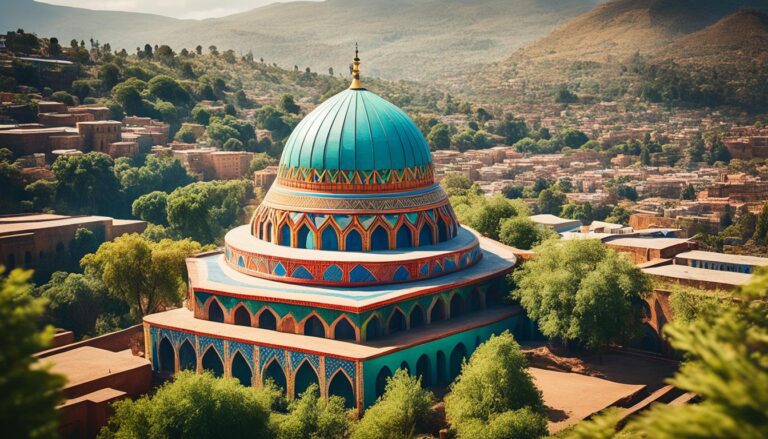What Are The Different Tribes Of Ethiopia?
The Oromo Tribe: A Rich Culture and History
The Oromo people are the largest ethnic group in Ethiopia, known for their rich cultural heritage and vibrant history. They primarily reside in the Oromia region of Ethiopia and have a population that exceeds 35 million, making up nearly a third of the country’s population.
The Oromo tribe is known for its Gada system, a traditional governance system that is based on democratic principles and involves age-based social classes. This system has been a defining feature of Oromo society for centuries, emphasizing the importance of social cohesion, justice, and equality among its members.
One of the most significant aspects of Oromo culture is the celebration of the Irreecha festival, which is an annual thanksgiving event that marks the end of the rainy season and the beginning of the harvest season. During this colorful and joyous festival, people come together to give thanks to Waaqa (God) and pray for prosperity, peace, and unity.
The Oromo people have a deep connection to their cultural heritage, which is evident in their music, dance, and artistic traditions. Traditional Oromo music often features the use of instruments such as the kirar (a stringed instrument) and qeerroo (a flute), while Oromo dance styles are characterized by energetic and rhythmic movements.
In recent years, there has been a renewed interest in promoting and preserving Oromo culture and identity, with efforts to revitalize traditional practices and languages. Despite facing challenges and historical injustices, the Oromo tribe continues to uphold its cultural values and traditions, making significant contributions to Ethiopia’s diverse cultural tapestry.
The Amhara Tribe: Traditions and Customs
The Amhara tribe is one of the most prominent and populous ethnic groups in Ethiopia, known for its rich traditions and customs that have been passed down through generations. They primarily reside in the central highlands of Ethiopia and have played a significant role in shaping the country’s history and culture.
One of the key aspects of the Amhara tribe is its strong ties to the Ethiopian Orthodox Church. Religion plays a central role in the lives of the Amhara people, influencing their traditions, ceremonies, and way of life. Many traditional practices, such as weddings, funerals, and festivals, are deeply rooted in the Christian faith.
The Amhara tribe is also known for its unique cultural heritage, including music, dance, and cuisine. Traditional music forms an integral part of Amhara society, with rhythmic beats and melodic tunes often accompanying celebrations and gatherings. Additionally, traditional Amhara cuisine, which includes dishes such as injera (a sourdough flatbread) and wat (a spicy stew), reflects the tribe’s culinary expertise.
Moreover, the Amhara tribe takes great pride in its intricate weaving and pottery skills. Hand-woven textiles, such as shawls and clothing items, showcase the Amhara people’s craftsmanship and attention to detail. Similarly, pottery-making is a revered art form among the Amhara, with clay pots and containers being essential items in daily life.
In terms of social structure, the Amhara tribe has a hierarchical system that values respect for elders and traditional authorities. Family ties are strong within the community, and kinship plays a vital role in shaping societal norms and values.
The Amhara tribe’s traditions and customs are a testament to their deep-rooted cultural heritage and collective identity. By preserving and passing down their customs to future generations, the Amhara people continue to uphold their rich legacy and contribute to Ethiopia’s diverse tapestry of ethnic groups.
The Tigray Tribe: Ancient Roots and Unique Practices
The Tigray people are an ethnic group inhabiting the Northern region of Ethiopia, known for their rich history and distinctive cultural practices. With a heritage dating back to ancient times, the Tigrayan identity is deeply rooted in traditions that have been passed down through generations.
One of the unique features of the Tigray tribe is their language, Tigrinya, which belongs to the Semitic branch of the Afro-Asiatic language family. This ancient language is essential to the preservation of their cultural heritage and is spoken by the majority of Tigrayan people.
The Tigray tribe is predominantly Christian, belonging to the Ethiopian Orthodox Tewahedo Church. Religion plays a significant role in their daily lives, influencing customs, celebrations, and societal norms. Religious festivals and ceremonies are integral to the Tigrayan culture, providing a sense of community and spiritual connection.
Traditional attire is another distinct aspect of the Tigray tribe. Women often wear brightly colored dresses adorned with intricate designs, while men can be seen in white tunics paired with shawls. These garments not only serve as a form of cultural expression but also reflect the artistry and craftsmanship of the Tigrayan people.
In addition to their rich cultural heritage, the Tigray tribe is known for its unique architectural marvels, such as the rock-hewn churches of Lalibela and the ancient monasteries of Lake Tana. These historical sites attract visitors from around the world, showcasing the craftsmanship and ingenuity of the Tigrayan people.
Despite facing challenges such as political unrest and environmental hardships, the Tigray tribe remains resilient and steadfast in preserving their cultural identity. Through their strong sense of community, unwavering faith, and commitment to tradition, the Tigrayan people continue to thrive and uphold their ancient roots in the modern world.
The Afar Tribe: Nomadic Lifestyle and Resilience
The Afar tribe, also known as the Danakil, are a proud and resilient group of people who primarily inhabit the Afar Triangle, a region in the Horn of Africa that includes Ethiopia, Eritrea, and Djibouti. With a population of approximately 1.5 million, the Afar tribe is known for their nomadic lifestyle, adaptability to harsh environments, and unique cultural practices.
One of the most distinctive features of the Afar tribe is their ability to thrive in one of the most inhospitable places on Earth. The Afar Triangle is characterized by arid deserts, active volcanoes, and extreme temperatures, yet the Afar people have developed a deep understanding of the land and its resources, allowing them to sustain their traditional way of life for centuries.
The Afar tribe is organized into clans, each led by a sultan who oversees the community’s affairs and represents them in external matters. The Afar people are skilled herders, known for their management of livestock such as goats, camels, and cattle. These animals play a crucial role in the tribe’s economy and provide sustenance in the form of milk, meat, and hides.
In addition to their expertise in animal husbandry, the Afar tribe is also renowned for their resilience in the face of adversity. Despite facing challenges such as droughts, political unrest, and conflicts with neighboring groups, the Afar people have persevered and maintained their cultural identity. Their ability to adapt to changing circumstances and their unwavering sense of pride in their heritage have enabled them to endure and flourish in a challenging environment.
The Afar tribe’s traditional attire is a reflection of their vibrant culture and heritage. Both men and women wear brightly colored garments decorated with intricate patterns and designs. Women, in particular, are known for their elaborate jewelry and hairstyles, which hold symbolic significance within the community.
The Afar tribe’s nomadic lifestyle, resilience, and rich cultural traditions make them a truly remarkable group of people. Despite the harsh conditions of their environment, the Afar tribe continues to thrive, relying on their deep connection to the land and their strong sense of community to sustain them through generations.
The Mursi Tribe: Famous for Lip Plates and Colorful Attire
The Mursi Tribe, a fascinating ethnic group residing in the remote Omo Valley in Ethiopia, is renowned for their distinctive customs and adornments, particularly the women’s practice of wearing lip plates. This unique tradition involves inserting and stretching the lower lip to accommodate a clay or wooden plate, a symbol of beauty and cultural identity among the Mursi people.
The Mursi Tribe’s elaborate attire is another striking feature that sets them apart. Women often wear colorful beaded necklaces, intricate headpieces, and leather skirts adorned with shells and metal embellishments, reflecting their artistry and pride in cultural heritage. Men typically don loincloths and body paint for rituals and ceremonies, showcasing a blend of tradition and creativity in their dress.
Beyond their striking appearance, the Mursi Tribe also has a rich oral tradition, with storytelling playing a vital role in passing down history, myths, and wisdom from one generation to the next. Elders hold significant respect within the community as custodians of knowledge and guardians of cultural practices, ensuring continuity and preservation of the Mursi way of life.
Living in harmony with nature, the Mursi people practice subsistence farming and cattle herding, relying on the land for sustenance and livelihood. Their semi-nomadic lifestyle entails moving with the seasons in search of fertile grazing lands and water sources for their cattle, showcasing their deep connection to the environment and traditional practices that have sustained them for centuries.
In recent years, increased exposure to modern influences and tourism has posed challenges to the preservation of Mursi cultural traditions. While economic opportunities have emerged through the sale of crafts and tourist visits, there is a delicate balance between cultural authenticity and outside pressures that threaten to erode the unique heritage of the Mursi Tribe.
The Mursi Tribe stands as a testament to resilience, creativity, and cultural pride, embodying a vibrant tapestry of traditions and customs that captivate visitors and researchers alike. Their legacy endures through their distinctive practices, colorful attire, and unwavering commitment to preserving their identity in a rapidly changing world.
Conclusion
In the vibrant tapestry of Ethiopia’s diverse population, each tribal group we have explored offers a unique and fascinating insight into the country’s rich cultural heritage. The Oromo tribe, with its deep-rooted history and traditions, stands out as one of the largest ethnic groups in Ethiopia, known for their vibrant music, dance, and folklore. Their distinct way of life, resilience, and strong sense of community continue to be a hallmark of their cultural identity.
Moving on to the Amhara tribe, we discover a proud people who value tradition and customs that have been passed down through generations. Their intricate ceremonies, elaborate clothing, and deep-rooted religious beliefs offer a glimpse into a society that treasures its history while embracing modernity. The Amhara people’s contributions to Ethiopia’s art, music, and literature have left an indelible mark on the country’s cultural landscape.
The Tigray tribe, with its ancient roots and unique practices, presents a fascinating blend of history and innovation. From their iconic rock-hewn churches to their rich oral traditions, the Tigrayan people have preserved their cultural heritage with a deep sense of pride. Their resilience in the face of adversity and their commitment to preserving their traditions serve as a testament to the enduring spirit of the Ethiopian people.
In contrast, the Afar tribe offers a window into a nomadic lifestyle defined by strength, endurance, and resilience. As wanderers of the arid Afar region, these resourceful people have adapted to their harsh environment with remarkable skill and ingenuity. Their mastery of survival in one of the world’s most unforgiving terrains is a testament to the indomitable human spirit that thrives against all odds.
The Mursi tribe captivates with its striking visual identity, characterized by the women’s practice of wearing lip plates and colorful attire. Beyond their striking appearance, the Mursi people are known for their rich artistic traditions, storytelling, and unique way of life in the Omo Valley. Their customs and rituals offer a glimpse into a world where individuality, creativity, and cultural expression are revered.
The diverse tribes of Ethiopia represent a kaleidoscope of traditions, histories, and identities that collectively form the intricate tapestry of Ethiopian culture. Each tribe we have explored offers a unique perspective on what it means to be Ethiopian, highlighting the resilience, creativity, and diversity that define this ancient and vibrant nation. Through their customs, traditions, and way of life, these tribes contribute to the rich tapestry of Ethiopian culture, weaving together a narrative of strength, beauty, and enduring heritage that continues to inspire and captivate the world.






